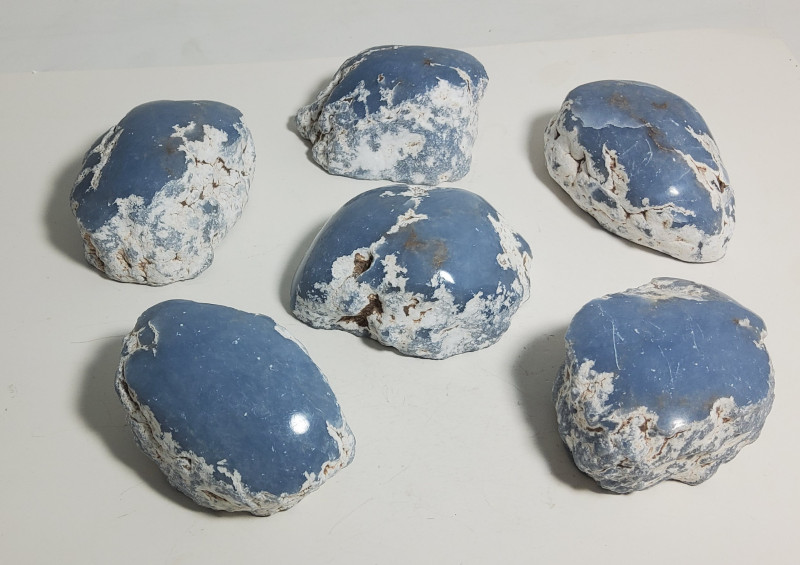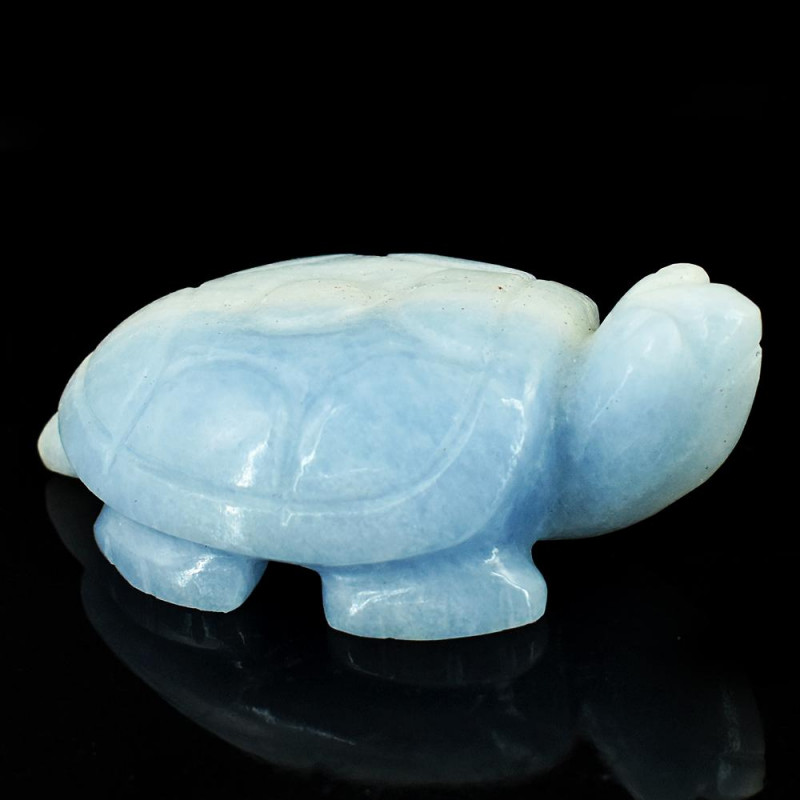
硬石膏(天使石)宝石:属性、含义和价值指南
 硬石膏是一种浅色半透明的晶体,也被称为天使石。硬石膏是宝石吗?当然是!不过,你通常更常在雕刻品中看到它,而不是刻面珠宝。
硬石膏是一种浅色半透明的晶体,也被称为天使石。硬石膏是宝石吗?当然是!不过,你通常更常在雕刻品中看到它,而不是刻面珠宝。
那么,硬石膏是稀有还是常见?作为一种矿物,它比较常见,但很难找到,因为它很容易变成其他矿物。宝石级硬石膏非常罕见。
硬石膏是什么颜色?通常,市面上出售的水晶和宝石呈冰川蓝色或淡紫色,带有雪花状斑点。透明的硬石膏也可能是无色或紫色。半透明的硬石膏颜色可以是白色、棕褐色、灰色、玫瑰色或淡紫色。
想买硬石膏首饰吗?快来看看这份指南,了解选购硬石膏的注意事项,以及它的疗愈功效、含义、价格等等!

关于硬石膏
硬石膏是一种颜色柔和的半宝石。虽然有些人认为“天使石”是同义词,但也有人认为天使石是产自秘鲁的蓝灰色硬石膏品种。
当提及某个品种时,天使石也可能被称为“蓝色硬石膏”。在本文中,我们将使用“天使石”作为硬石膏的广义同义词,但在讨论宝石的具体细节时,则将其用作品种名称。
从占星学角度来看,天使石是水瓶座的守护石。天使石对水瓶座的益处包括缓解紧张和固执,用同理心和内心的平静取代这些情绪。
除了占星术和宝石用途外,硬石膏还有什么用途?硬石膏的工业用途包括:
清漆、水泥、油漆和灰泥中的干燥添加剂
墙板和灰泥的成分(含石膏)
用于制造硫酸的硫源
土壤处理中富含钙的成分(粉碎后)
硬石膏的许多工业用途与石膏相似。事实上,硬石膏在土壤处理方面甚至比石膏更好,因为它缺乏水分,这意味着它能提供更多的钙。但从化学角度来看,这两种石头基本上是兄弟!
 上图:石膏亚硒酸盐
上图:石膏亚硒酸盐
硬石膏与石膏
还记得我们提到过硬石膏经常会变成另一种矿物吗?这种矿物就是石膏!
石膏的成分与硬石膏相同,只是添加了水。因此,硬石膏受潮后会变成石膏。相反,脱水后的石膏也会变成硬石膏,尽管这种情况在自然界中并不常见。
硬石膏和石膏通常都是白色的,带有白色条纹和玻璃光泽。
然而,硬石膏和石膏之间存在一些关键区别:
稀有性:石膏比硬石膏更常见。
硬度:石膏比硬石膏(莫氏硬度为3-3.5)略软(莫氏硬度为2)。
含水量:如上所述,石膏含水,而硬石膏不含水。
值得注意的是,一种被称为“精制石膏”的粉末实际上是无水的(不含水),由约30%的钙和23.5%的硫组成。作为参考,纯石膏的钙含量约为23%,硫含量接近19%。
说到矿物特性……

硬石膏规格和特性
硬石膏矿物是一种硫酸钙,化学式为 CaSO4。硬石膏晶体含有水吗?不,它们是无水的——这个词源于希腊语“ anhydros ”,意思是“无水的”。因此得名!
正如其绰号中的天使一样,这颗宝石非常脆弱。它非常柔软, 莫氏硬度仅为3-3.5。此外,它的解理面很容易向三个方向裂开,因此从任何一个角度猛烈撞击都会导致宝石破碎。
事实上,硬石膏还有一个绰号叫“立方体晶石”。这个绰号源于这种石头90度的解理角可以裂开,内部呈现出类似立方体的形状。然而,硬石膏是正交晶系,而非立方体。
硬石膏的晶体呈厚实的棱柱状或板状(薄,四面体)。硬石膏更常形成纤维状脉状,沿解理断裂成碎片。它也常形成结节状(表面呈球状)、块状或粒状的块体。
其余硬石膏矿物特性如下:
莫氏硬度:3-3.5
颜色:透明宝石 - 无色、浅蓝色或紫色;半透明至不透明宝石 - 白色、棕褐色、灰色、玫瑰色或淡紫色
晶体结构:正交
光泽: [010] 处为珍珠光泽, [001] 处为玻璃光泽至油脂光泽, [100] 处为玻璃光泽; 块状种类 - 玻璃质 (玻璃状)
透明度:透明至不透明
折射率:1.57-1.61
密度:2.9-3.0
解理:完美,3向,平行于对称平面
断口:不均匀、碎片状或贝壳状
条痕:白色
发光:加热时有时会发出荧光;德国材料在长波紫外线下会发出红色荧光
多色性:存在于紫色晶体中 - 紫色、淡紫色/玫瑰色和淡黄色/无色

硬石膏的种类
硬石膏有三种,它们的商品名不一定代表其所属的品种,但在选购这种宝石时,了解它们很重要。我们还会解答关于天使石和天青石的困惑。
天使石

天使石(也称为天使石或天使石)是一种不透明的天蓝色、灰蓝色或淡紫色硬石膏的商品名。它们通常带有白色斑点,也可能带有深红色到棕色的斑点。
肠结石
“肠石”这个商品名远没有那么神奇,指的是折叠结核(致密块)中的硬石膏。这些褶皱的形状类似于人体内部折叠的肠子。有时,扭曲的结核也被称为“牛肚石”,因为牛胃壁被称为牛肚。
火石
硬石膏(Vulpinite)是一种产自意大利沃尔皮诺的灰白色纹理硬石膏。这种石头呈颗粒状和鳞片状,但又带有大理石般的质感。它在沃尔皮诺当地更受欢迎。
蓝色“埃及”硬石膏
 图片来源:带支架的眼影罐,约公元前 1878 年至 1749 年 |大都会艺术博物馆
图片来源:带支架的眼影罐,约公元前 1878 年至 1749 年 |大都会艺术博物馆
蓝色“埃及”硬石膏是最神秘的一种。古埃及人将白色和抛光的蓝色硬石膏用于装饰,但他们从哪里获得这些蓝色材料仍不得而知。
天使石与天青石
天青石,通常是一种透明至淡蓝色的晶体。这意味着它的名字和外观都与天使石相似,都散发着空灵的气息。
但天青石和天使石是一样的吗?不一样。它们都是正交晶系,透明到半透明,莫氏硬度为3-3.5,但它们是完全不同的矿物。
天使石(硬石膏)和天青石有何不同?
成分:天青石是硫酸钙,而天青石是硫酸锶。
密度:天青石的密度(2.9-3.0)小于天青石(3.9-4.0)。
尽管存在差异,但 angelite 的含义与 celestite 非常相似。
 图片来源:微型西普斯(魔法石碑),荷鲁斯侧面像,额头上戴着瞪羚头 MET DP112604 |大都会艺术博物馆
图片来源:微型西普斯(魔法石碑),荷鲁斯侧面像,额头上戴着瞪羚头 MET DP112604 |大都会艺术博物馆
硬石膏的意义和历史
天使石又被称为“意识之石”,象征着爱、光明和精神觉知。一些人认为,天使石是天使赐予人类的礼物,因此它又被赋予了第二个绰号——“天使连接之石”。
然而,硬石膏晶体的精神意义并不全是空想——人们相信它具有平衡能力,让你脚踏实地,同时让你的精神翱翔和探索。
历史
硬石膏的用途可以追溯到古代。在古埃及,白色和蓝色的硬石膏曾被用来制作装饰品,例如一个公元前1938年至1700年用来盛放眼部化妆品的罐子,目前收藏于布鲁克林博物馆。
硬石膏最早发现于1794年奥地利的霍尔盐矿。虽然石膏更靠近地表(地下水附近),但硬石膏的埋藏深度更深。德国地质学家亚伯拉罕·戈特洛布·韦伦纳于1804年将其命名为“硬石膏”。
其中一个过时的名称是氯化物(或氯化物)矿物,源于人们错误地认为它是一种氯化物(或氯化物)矿物。
20世纪,英国雕塑家奥菲莉亚·戈登·贝尔(Ophelia Gordon Bell)的硬石膏雕刻作品堪称一例。贝尔受美国联合硫酸公司(United Sulphuric Acid Corporation)委托,创作了一幅硬石膏窑浮雕。
发现天使石
美国宝石学家约翰·伊尔马里·科伊武拉(John Ilmarii Koivula)和RC·卡默林(RC Kammerling)后来才发现天使石。天使石是在1987年秘鲁马丘比丘的“和谐汇聚”(Harmonic Convergence)活动期间发现的,这是一场旨在促进世界和平的全球冥想活动。
此次活动原计划与一个据称超自然的预言相吻合,该预言与八颗行星罕见(且真实)排列成“大三角”的现象有关。(类似“携手美国”活动,但包含更多占星学元素和全球参与。)
天使石的许多精神意义都与它在这次事件中的发现息息相关。那么,天使石有什么用呢?

硬石膏的治疗功效
宝石的颜色会影响其疗愈石的功效。无色至白色的硬石膏具有白色宝石的清洁、提升智力和净化功效。
像天使石这样的蓝色宝石,具有舒缓和促进沟通的功效。因此,天使石脉轮石最适合打开喉轮,让人能够真实地理解和表达自我。
对于身体和情感的治疗,硬石膏晶体有什么作用?
身体康复
水晶治疗师使用硬石膏来帮助:
咽喉感染
心脏和循环问题
头痛
免疫系统功能
甲状腺问题
注意力不集中
情绪疗愈
从情感上来说,硬石膏的好处可以促进:
自我意识
内心的平静
自我表达
目标感
此外,据说水晶还能驱散愤怒和忧虑,代之以接纳、同理心和自我理解。它还能提升正念,帮助人们活在当下。

硬石膏宝石特性
硬石膏的客观价值取决于其颜色、切工、净度和透明度。
颜色
硬石膏几乎总是拥有柔和、浅淡的色调。最有价值的颜色是粉色、紫色或蓝色。
天使石的白色中心和斑点是由石膏或石英内含物造成的,而其他可能的锈色至棕色斑点则来自赤铁矿。颜色较深的色调可能会降低天使石的价值。
切
由于稀有且难以精确切割, 刻面硬石膏并不常见。硬石膏和天使石通常被切割成凸圆形。然而,天使石最常见的是雕刻。秘鲁的天使石雕刻品种类繁多,从动物雕像、魔杖到蛋形和球体,应有尽有。
清晰度和透明度
净度描述宝石中可见内含物的数量,因此会影响透明度。透明度更高、净度更好的硬石膏价值更高。
硬石膏中常见的包裹体包括共生晶体和多相空腔,或含有不同形态(即液体、固体、蒸汽)包裹体的区域。

硬石膏的形成和来源
硬石膏是一种蒸发岩,指的是水从海洋或非海洋沉积物中蒸发时形成的沉积矿物。通常,这种矿物最初是石膏,然后脱水形成硬石膏。
这种矿物存在于沉积矿床、火成岩、盐丘盖和盐盆中,通常位于石膏、石灰岩或玄武岩空洞层周围。
采矿地点
硬石膏在哪里发现?除了奥地利和秘鲁的早期产地外,现在硬石膏还产自以下地区:
英国
埃及
德国
利比亚
墨西哥
波兰
美国(纽约)

硬石膏的价格和价值
尽管硬石膏很稀有,但其价格却很实惠!
硬石膏凸圆形宝石的批发价约为每克拉0.10美元。雕刻品的价格因工艺和尺寸而异,但一般每颗售价在5至40美元之间。天使石原石的价格仅为每克拉0.02至0.10美元。
串珠天使石手链的价格通常在5美元到30美元之间,但有些甚至在60美元左右。天使石吊坠的价格根据卖家不同,在5美元到90美元之间,串珠项链的价格则略高一些,在60美元到150美元之间。
一旦找到了自己喜欢的宝石,您会如何保养天使石呢?
硬石膏的保养和维护
对硬石膏进行适当的宝石护理至关重要。首先,它吸水迅速且容易,因此必须远离任何潮湿或潮湿的地方。此外,硬石膏质地柔软,且具有完美的解理结构,因此很容易出现划痕和破损。
我们建议只佩戴硬石膏耳环或项链,以免损坏。对于串珠串珠,每颗珠子之间必须有明显的结或保护措施。务必选择带有保护性镶嵌的硬石膏首饰。
最好将项链佩戴在布料上,而不是直接戴在皮肤上,以防止汗水渗入皮肤。你可以用柔软、无尘的干布擦拭项链。

获得你自己的天使石!
尽管对大多数人来说,硬石膏还算现代,但它却已成为天赐之石。这颗稀有宝石象征着新机遇的晴空,助您拥抱真我,同时又能让您脚踏实地,享受每一刻!
搜索Gemstone Encyclopedia
最新的文章
彩虹格纹日光石是一种长石,由于内部含有各种包裹体,呈现出三种绚丽的光学效应。它绚丽多彩的光泽和格纹图案使其成为收藏家梦寐以求的珍宝!
12th Jan 2026
文章分类
How To's is where you will find helpful articles from gem Rock Auctions on how to cut gemstones, select gemstones and buy gemstones.
9文章数
